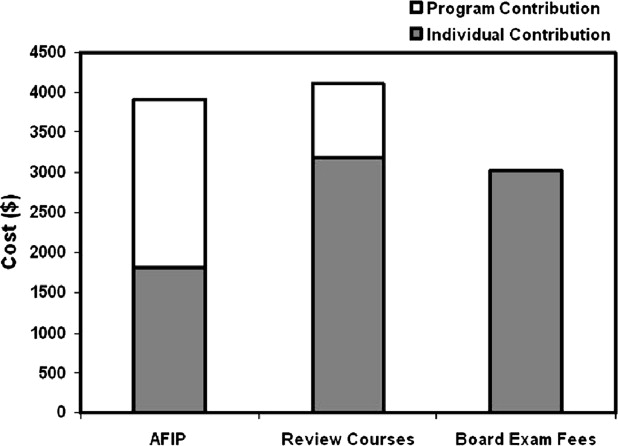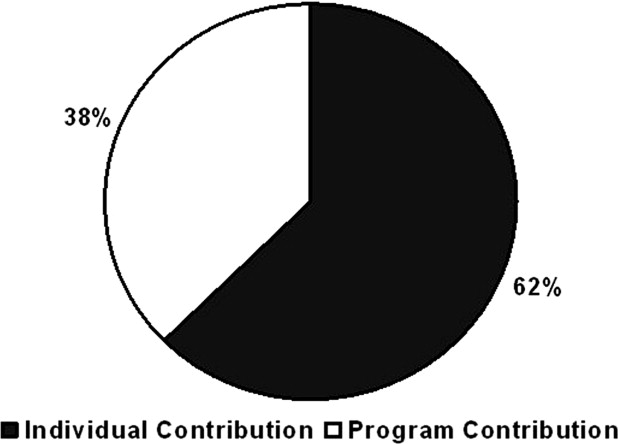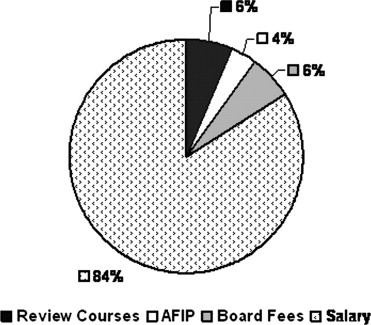Rationale and Objectives
The purpose of this study is to document the degree of self-subsidization of educational expenses by senior radiology residents.
Materials and Methods
Questionnaires were distributed to all radiology residents ( n = 176) attending the New Jersey Medical School board review course held twice in 2006. Respondents ( n = 175) documented the number and source of financial support for review courses they had or would attend, including the AFIP course in radiologic pathology. They also listed the amount of additional financial allowances paid to them by their programs and cited the funding source for the radiology board examinations.
Results
Average AFIP expenditure, including tuition, room, board, and travel, equaled $3,969 ± $45, of which 46% was paid by the residents themselves. The respondents attended, on average, two review courses costing $4,116 ± $149, bearing 77% of the costs. The average additional allowance paid to residents was $1,938 ± $156. Total board expenditures of $3,120, including fees and travel, were borne entirely by the residents. Total out-of-pocket expenses for these activities was $7,928 ± $165, which amounted to 16% of senior residents’ average annual salary ($49,746).
Conclusion
The desire by both programs and trainees for success on the radiology board examination has stimulated the growth of review courses. The enduring popularity of the AFIP course has made this activity an essential rotation for most radiology residency programs. Each of these off-site opportunities incurs significant financial obligations to residents, and when added to the cost of the board exams, equals 16% of their average annual salary. Thus radiology residents are subsidizing their education to a considerable degree relative to their salaries. This study reveals that senior radiology residents significantly subsidize their education and bear the burden of hidden costs associated with their training.
As radiology residents enter their third and fourth years of training, board preparation looms large as a component of their educational experience. The desire by both programs and trainees for success on the radiology board examinations has stimulated the growth of review courses. Based on the approximate number of available slots in popular review courses and the number of graduating residents, we estimated that more than 90% of radiology residents attend board review courses. These respites from clinical duties are often sanctioned by their respective programs. Moreover the enduring popularity of the 6-week Armed Forces Institute of Pathology (AFIP) course that takes place in Washington, DC, has made this activity, too, a seemingly essential rotation for most radiology residency programs, with close to 100% attendance by US radiology residents demonstrated in this study. Each of these off-site opportunities incurs a financial obligation for senior radiology residents who must also pay for the cost of the board exams themselves. It is reasonable to question, then, that if deemed beneficial for programs that trainees participate in these activities, (1) what are their costs, and (2) what proportion is borne by the residents themselves?
This study documents the degree of self-subsidization of educational expenses assumed by radiology residents as they complete their training.
Methods
Get Radiology Tree app to read full this article<
Get Radiology Tree app to read full this article<
Get Radiology Tree app to read full this article<
Get Radiology Tree app to read full this article<
Get Radiology Tree app to read full this article<
Get Radiology Tree app to read full this article<
Results
Get Radiology Tree app to read full this article<
Get Radiology Tree app to read full this article<
Discussion
Get Radiology Tree app to read full this article<
Get Radiology Tree app to read full this article<
Get Radiology Tree app to read full this article<
Get Radiology Tree app to read full this article<
Get Radiology Tree app to read full this article<
Get Radiology Tree app to read full this article<
Get Radiology Tree app to read full this article<
References
1. Teichman J.M., Bernheim B.D., Espinosa E.A., et. al.: How do urology residents manage personal finances?. Urology 2001; 57: pp. 866-871.
2. Teichman J.M., Cecconi P.P., Bernheim B.D., et. al.: How do residents manage personal finances?. Am J Surg 2005; 189: pp. 134-139.
3. Teichman J.M., Matsumoto E., Smart M., et. al.: Personal finances of residents at three Canadian universities. Can J Surg 2005; 48: pp. 27-32.
4. Tu H.T., Ginsburg P.B.: Losing ground: physician income, 1995–2003. Track Rep 2006; 15: pp. 1-8.
5. Centers for Medicare and Medicaid Services: Changes to the hospital inpatient prospective payment systems and fiscal year 2007 rates.2006.pp. 804-862.
6. Martin D.R., Kazzi A.A., Wolford R., et. al.: Report from the Council of Emergency Medicine Residency Directors subcommittee on graduate medical education funding: effects of decreased medicare support. Acad Emerg Med 2001; 8: pp. 809-814.
7. Reid J.R., Goske M.J., Hewson M.G., et. al.: Creating an international comprehensive web-based curriculum in pediatric radiology. AJR Am J Roentgenol 2004; 182: pp. 797-801.
8. Durfee S.M., Jain S., Shaffer K.: Incorporating electronic media into medical student education: a survey of AMSER members on computer and web use in radiology courses. Acad Radiol 2003; 10: pp. 205-210.
9. Rosset A., Rosset A., Ratib O., et. al.: Integration of a multimedia teaching and reference database in a PACS environment. Radiographics 2002; 22: pp. 1567-1577.
10. Wiggins R.H., Davidson H.C., Dilda P., et. al.: The evolution of filmless radiology teaching. J Digit Imaging 2001; 14: pp. 236-237.
11. Wiggins R.H., Katzman G.L., Dilda P., et. al.: Distance learning in the digital environment. J Digit Imaging 2001; 14: pp. 145-146.


